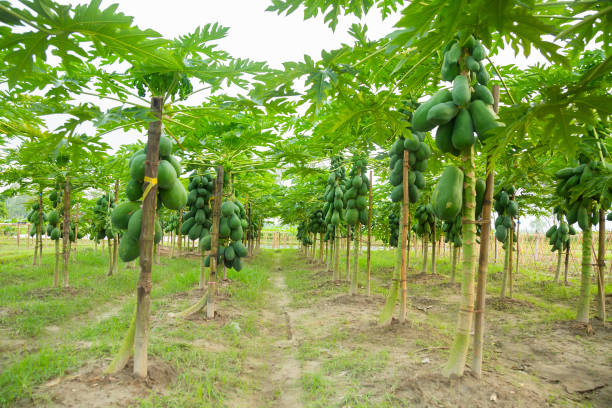If you’re looking for a fast-growing, nutrient-rich, and low-maintenance fruit tree for your garden or farm, Papaya (Carica papaya) should top your list. Known for its vibrant orange pulp and powerful health benefits, papaya trees flourish in Indian soil and climate. Whether you’re a home gardener or a farmer, the papaya tree offers a quick return on investment, consistent fruiting, and numerous ecological and health advantages.
In this detailed guide, we explore everything from how to plant and care for papaya trees to their economic and health benefits — along with internal links to similar fruit tree guides to help you diversify your orchard.
Why Papaya Is Perfect for Indian Soil
India’s tropical and subtropical regions provide the ideal environment for papaya cultivation. The tree loves warm temperatures, moderate rainfall, and well-drained soil, making it suitable for most parts of the country.
Key Benefits of Growing Papaya:
- Fast Growth: Papaya matures quickly, with fruit appearing within 6–9 months of planting.
- Low Maintenance: Requires minimal care compared to many other fruit trees.
- High Yield: A single healthy tree can produce up to 100 fruits annually.
- Health Boosting: Rich in vitamin C, A, folate, and digestive enzymes like papain.
- Space-Efficient: Perfect for small gardens due to its vertical growth.
Best Climate and Soil for Papaya Trees
Papaya thrives in temperatures between 22°C and 35°C. It cannot tolerate frost or waterlogged soil.
Ideal Conditions:
- Soil: Sandy loam or alluvial soil with pH 6.0 to 6.5
- Watering: Regular but not excessive
- Sunlight: Full sun exposure for at least 6–8 hours daily
How to Grow Papaya in India
1. Selecting the Right Variety
Popular Indian varieties include:
- Pusa Delicious
- Coorg Honey Dew
- Red Lady 786
2. Propagation
Papaya is usually grown from seeds. Ensure seeds are sourced from ripe, disease-free fruits.
3. Land Preparation
- Dig pits of 45x45x45 cm
- Mix in organic compost and neem cake to deter pests
4. Planting
- Plant at 1.8 to 2.5 meters apart
- Choose a sunny location for optimum growth
5. Fertilization
- Use a balanced NPK fertilizer monthly during the growing season
- Apply vermicompost or cow dung every 30–40 days
6. Irrigation
- Water regularly, especially during flowering and fruiting
- Avoid overwatering to prevent root rot
7. Pest & Disease Control
- Monitor for aphids, mealybugs, and fungal diseases
- Use organic neem spray or soap solution for minor infestations
Health Benefits of Eating Papaya
Nutritional Value (per 100g):
- Calories: 43 kcal
- Vitamin C: 60.9 mg
- Vitamin A: 950 IU
- Folate: 37 mcg
Top Health Benefits:
- Improves Digestion: Thanks to the enzyme papain
- Boosts Immunity: Rich in antioxidants and vitamins
- Supports Heart Health: Reduces cholesterol buildup
- Good for Skin: Helps fight acne and aging
Economic Benefits of Papaya Farming
Papaya offers one of the quickest returns in fruit farming. You can start harvesting within 6–9 months and continue fruiting for up to 2–3 years. A well-managed one-acre papaya farm can yield 30–40 tonnes annually, making it a lucrative option for Indian farmers.
Companion Fruit Trees for Your Garden
While papaya is powerful on its own, pairing it with other fast-growing, climate-compatible fruit trees can enhance your garden’s biodiversity and yield.
Explore our detailed guides on other must-plant Indian fruit trees:
- Add tropical sweetness with banana tree wonders
- Enhance your garden’s color and nutrition with pomegranate tree planting guide
- Include native varieties like the jamun tree
- Enjoy citrus freshness by growing lemon trees
- For creamy and cool summers, plant custard apple trees
- Indulge in mango mania with planting mango trees
- Add more sweetness with guava trees
- Taste the earth’s bounty with sapota (chikoo) trees
- Get tropical shade and sustainability from coconut tree plantation
Common FAQs About Papaya Tree Plantation in India
Q1: How long does it take for a papaya tree to bear fruit?
A: On average, a papaya tree starts fruiting 6–9 months after planting.
Q2: Can I grow papaya in pots or containers?
A: Yes, with proper care and drainage, dwarf varieties of papaya can be grown in large containers.
Q3: Is papaya farming profitable in India?
A: Absolutely. It’s one of the most profitable fruit crops due to its short maturation time and high yield.
Q4: What pests or diseases affect papaya trees?
A: Common issues include aphids, powdery mildew, and papaya ringspot virus. Organic treatments and crop rotation help reduce risks.
Q5: When is the best time to plant papaya in India?
A: The best planting seasons are spring (February–March) and monsoon (June–July).
Conclusion: The Papaya Advantage
Papaya trees stand out as one of the fastest-growing fruit trees in India. Their adaptability, nutritional richness, and economic value make them an excellent addition to both home gardens and commercial farms. Whether you’re looking to enjoy fresh fruit or build a sustainable green space, planting papaya is a smart and fruitful decision.
For more tree plantation ideas and eco-friendly gardening tips, explore more articles at treesplantsinfo.com.
